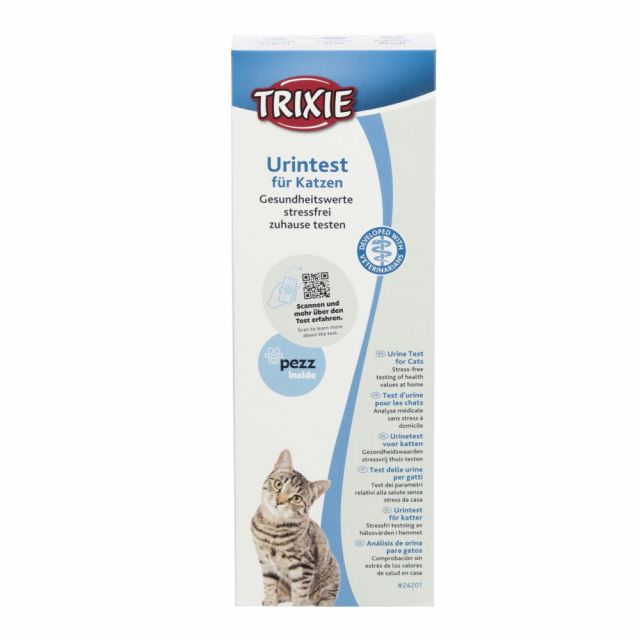Diabetes in the cat
Diabetes is a relatively common disease in usually older cats. Cats with diabetes lose weight significantly despite having a strong appetite. They also often drink and urinate a lot. If left untreated, a cat with diabetes will die. Fortunately, diabetes mellitus, the medical term for diabetes, is often treatable. Sometimes it is even reversible, and insulin treatment can be stopped over time! Pharmacy4pets is happy to assist you with the supplies for treating diabetes in your cat.
What exactly is diabetes?
A cat with diabetes or diabetes mellitus produces too little of the hormone insulin. Insulin facilitates the uptake of sugar (glucose) into the body's cells. Glucose is the main fuel for the body's cells. In diabetes, the sugar does not enter the cells. The cells do not receive fuel, and there is too much sugar in the blood. The excess glucose in the blood draws moisture out of the cells. Sugar and moisture are excreted.
How does diabetes develop?
The main cause of diabetes in cats is (just like in humans!) overweight and lack of exercise. Medications such as prednisone and the contraceptive pill also increase the risk of diabetes. In addition, about a quarter of all cats with diabetes have a tumor that produces growth hormone, leading to acromegaly and diabetes.
The symptoms of diabetes in cats
The main symptoms of a cat with diabetes are weight loss despite a good or often excessive appetite, and excessive drinking and urination. Cats with diabetes urinate a lot and are hungry. A cat with diabetes feels unwell, sleeps a lot, and grooms itself less, causing its coat to look poor. Often, these are cats that were overweight before they became ill. Some of these symptoms also occur in cats with an overactive thyroid or chronic kidney disease.
If diabetes persists untreated, the cat will become very weak and ill at some point and will stop eating and drinking. Vomiting can also be a symptom. Sometimes you may notice that the cat smells different (a bit like candy). This condition is called ketoacidosis. A cat with ketoacidosis is seriously ill and will need to be admitted for intensive treatment. Cats with diabetes have an increased risk of bacterial bladder infection or pyelonephritis. Sometimes cats with diabetes go blind or develop neurological symptoms in their hind legs.
Diagnosing diabetes in cats
After interviewing you and examining your cat, the vet probably suspects that your cat may have diabetes. Through a blood test, the vet checks the glucose level, or blood sugar level. In a cat with diabetes, this is (significantly) elevated. Because this can also increase due to stress, the vet will usually also test for fructosamines with an elevated glucose level; these increase with a prolonged high blood sugar level. Furthermore, it will be checked whether there is sugar in the urine, which is actually always the case in cats with diabetes. The urine is also checked for signs of a (bacterial) bladder infection.
Treating diabetes in cats
It is of the utmost importance to 'control' a cat with diabetes as quickly as possible, meaning to ensure a stable blood sugar level.
Insulin
In almost all cases, shortly after diagnosis, treatment begins with injecting insulin twice a day. The veterinarian will provide you with detailed explanations and demonstrate how to do this yourself. Consistency is very important here. The insulin must be injected at fixed times, and the blood sugar level must be checked every few days at the beginning. An excessively high blood sugar level must of course be normalized quickly, while simultaneously preventing a too low blood sugar level (hypoglycemia). To expedite the proper management of a cat with diabetes, a Freestyle Libre sensor can be placed on your cat, which continuously and painlessly measures the blood sugar level for fourteen days. Convenient tools are available for the correct dosing and injection of insulin: The VetPen Starter Kit and VetPen needles.
Nutrition
To minimize the variation in blood sugar levels throughout the day, it is advisable to feed cats with diabetes special dietary food with an adjusted carbohydrate (sugar) content. In these dietary foods, the proportion of fast sugars compared to slow sugars is also adjusted to keep the blood glucose level as stable as possible. In addition, the energy content of the food is reduced to help maintain a healthy weight. If insulin is started in a timely manner, diabetes is sometimes reversible. This means that the cat maintains a stable blood sugar level with just a modified diet.
Other treatments for diabetes
If there is acromegaly, removing the tumor will make the diabetes disappear. Stopping the contraceptive pill and/or corticosteroids if they are (partly) the cause of diabetes is essential. Antibiotics will be prescribed for a bacterial bladder infection. If a cat has ketoacidosis, hospitalization with infusion therapy is necessary.
Cats with low blood sugar levels
As the owner of a cat with diabetes, it is important to recognize the symptoms of low blood sugar levels. Low blood sugar or hypoglycemia ('hypo') occurs when too much insulin is injected. This can be due to a dosing error, but more often it is 'relatively' too much: if a cat eats poorly or not at all or vomits, the usual amount of insulin is usually too much. Also, if diabetes goes into remission, suddenly the previously correct amount can cause a hypo. The symptoms are:
- Hunger at odd times
- Restlessness, meowing
- Muscle tremors
- Appearing drunk / weak
- Coma
As soon as you suspect that your cat has a hypo, you should intervene. If your cat suddenly asks for food when it normally doesn't, give it some food. It is also good to always have grape sugar on hand. You can dissolve this in a little water and give it in the mouth. Smearing some honey on the inside of the lip also helps raise the blood sugar level. If your cat does not improve or is already weak, trembling, or even comatose, immediately call the veterinarian.
Preventing diabetes in cats
The main cause of diabetes in cats is overweight. Preventing overweight greatly reduces the risk of developing diabetes. If your cat is already overweight, a dietary food for overweight cats such as Sanimed Weight Reduction can help your cat achieve a healthy weight again. Sufficient exercise is a second important measure to help prevent diabetes. It is a myth that a lot of carbohydrates in cat food cause diabetes. However, once a cat has diabetes, it is important to adjust the amount and type of carbohydrates in the diet.
Since it is known that the contraceptive pill and corticosteroids increase the risk of diabetes, it is best not to give the contraceptive pill and to give corticosteroids only if strictly necessary. A very good alternative to the contraceptive pill is sterilization.
Preventing complications
To prevent complications of diabetes, it is important that you go to your veterinarian for a timely diagnosis at the first symptoms, such as weight loss or increased drinking and urination. The chance of reversibility of the disease is much greater if treatment is started in a timely manner. You can test your cat's urine for the presence of sugar at home using convenient urine test strips. Diabetes is an unpleasant but treatable chronic disease. With timely intervention, a motivated owner, and adjustments to diet and lifestyle, a cat with diabetes can lead a happy life for many years. Pharmacy4pets will help you with the supplies for insulin therapy and the right nutrition for your cat.
If you have any questions about our products or about diabetes in cats, please contact us.



